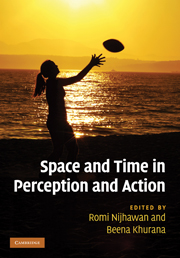Book contents
- Frontmatter
- Contents
- List of contributors
- Acknowledgments
- 1 Space and time: the fabric of thought and reality
- Part I Time–space during action: perisaccadic mislocalization and reaching
- 2 The internal eye position signal, psychophysics, and neurobiology
- 3 Factors influencing perisaccadic visual mislocalization
- 4 Visual and nonvisual factors in perisaccadic compression of space
- 5 Keeping vision stable: rapid updating of spatiotopic receptive fields may cause relativistic-like effects
- 6 Combined influences of extraretinal signals, retinal signals, and visual induction on space perception and manual behavior in perisaccadic and steady viewing
- 7 Space constancy: the rise and fall of perceptual compensation
- 8 Intercepting moving objects: do eye movements matter?
- 9 The utility of visual motion for goal-directed reaching
- Part II Temporal phenomena: perception
- Part III Temporal phenomena: binding and asynchrony
- Part IV Spatial phenomena: forward shift effects
- Part V Space–time and awareness
- Index
- References
9 - The utility of visual motion for goal-directed reaching
from Part I - Time–space during action: perisaccadic mislocalization and reaching
Published online by Cambridge University Press: 05 October 2010
- Frontmatter
- Contents
- List of contributors
- Acknowledgments
- 1 Space and time: the fabric of thought and reality
- Part I Time–space during action: perisaccadic mislocalization and reaching
- 2 The internal eye position signal, psychophysics, and neurobiology
- 3 Factors influencing perisaccadic visual mislocalization
- 4 Visual and nonvisual factors in perisaccadic compression of space
- 5 Keeping vision stable: rapid updating of spatiotopic receptive fields may cause relativistic-like effects
- 6 Combined influences of extraretinal signals, retinal signals, and visual induction on space perception and manual behavior in perisaccadic and steady viewing
- 7 Space constancy: the rise and fall of perceptual compensation
- 8 Intercepting moving objects: do eye movements matter?
- 9 The utility of visual motion for goal-directed reaching
- Part II Temporal phenomena: perception
- Part III Temporal phenomena: binding and asynchrony
- Part IV Spatial phenomena: forward shift effects
- Part V Space–time and awareness
- Index
- References
Summary
Summary
Visual information is crucial for goal-directed reaching. Recently a number of studies have shown that motion in particular is an important source of information for the visuomotor system. For example, when reaching for a stationary object, nearby visual movement, even when irrelevant to the object or task, can influence the trajectory of the hand. Although it is clear that various kinds of visual motion can influence goal-directed reaching movements, it is less clear how or why they do so. In this chapter, we consider whether the influence of motion on reaching is unique compared to its influence on other forms of visually guided behavior. We also address how motion is coded by the visuomotor system and whether there is one motion processing system that underlies both perception and visually guided reaching. Ultimately, visual motion may operate on a number of levels, influencing goal-directed reaching through more than one mechanism, some of which may actually be beneficial for accurate behavior.
Introduction
Visual motion is constantly produced as we move our eyes and head and as objects move in the world. The visuomotor system, therefore, faces a serious challenge in that it must register target as well as background motion and then segment these different sources of motion in order to direct actions to objects. Over the last three decades, a broad and expanding literature has examined how the visuomotor system processes and uses visual motion in goal-directed behavior.
- Type
- Chapter
- Information
- Space and Time in Perception and Action , pp. 121 - 146Publisher: Cambridge University PressPrint publication year: 2010
References
- 1
- Cited by



